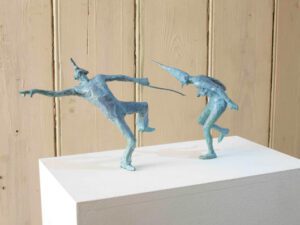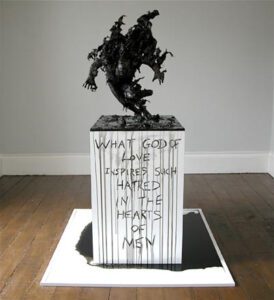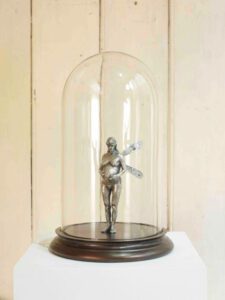
DG: So, when did you come down to Cornwall?
TS: I … I moved here September 1985 …
DG: Yes
TS: I was a first-year undergraduate at Falmouth School of Art
DG: So you came down here to be an art student at Falmouth.
TS: That’s right, yes
DG: … and you hadn’t been at any other place?
TS: I spent one year in Manchester in 84-85 and before that I left school to do my A-levels in Belfast at a college of further education
DG: So, you were much younger than then you are now so …
TS: Much (laughing)
DG: So, what was Cornwall like as an art scene in those days?
TS: Well Cornwall was very different – in fact Cornwall was very different – and I would say that if you were to draw a line where the difference begun probably around the year 2000, and I think that lottery money in the new millennium and things like that started to make big differences to the county. As a result, in projects, the art school turned into a university’s although it had a long to go – the University College, Falmouth – and the Maritime Museum’s coming along. When I first arrived in Cornwall the A30 was a single trunk road, most of it, so the journey – I remember my journey from Manchester by National Express to get here it was like I felt as if I was like travelling down into Europe it was like coming into a different country- it seemed – it was winter so it seemed warmer; these palm trees grew everywhere
DG: Yes
TS: The light was different to Manchester and as my tutor had said once said this is a paradise art college, it will be difficult to get into it because of its reputation. I arrived there, everything about it seemed like a paradise was the college is very beautiful and it did have a great reputation, the students. It appeared to me obviously not a student – it was a bit more like a large family and it seemed to me that for the art students, it became more a way of life for people … and they worked day and night and the art school was open the weekends; I think it still is and it just seemed very intense.
DG: How did paradise wear off?
TS: I’ll come to that in a minute, you mentioned Cornwall
DG: Yes.
TS: Cornwall also seemed much more remote than what it seems today although it still is of course, I can just use as an example that I’ve lived on this farm since1987 on and off I’ve been in other places. However it feels as if the town has moved closer by the glow in the sky not necessarily here but when you go over there, the sounds are different and you don’t have to go as far before you hit large amounts of traffic. Traffic is one of the big differences. The nature of the people is even different ,whether that’s to do with the youngster coming to a place that’s new – in some ways it seemed to have a lot more marginal and eccentric people around the people from the margins of society (laughing)
DG: More so than the now?
TS: Then than now? For example I think we’ve mentioned people like Doc Shields and co
DG: Oh, yes
TS Big characters . I guess that was one of the big things. Falmouth seems a lot more wealthy now. I think you’ve got to remember probably when I moved into this cottage it may have been worth 30 or £40,000 now its probably 300/3 ½ thousand pounds.
DG: I want to know in terms of the art scene and in terms of artist practice, how did it gradually decline, and what you remember, a particular points that telegraph to you that ‘this is a change in the scene’?
TS I don’t think there is a decline to be honest in the art scene
DG: Alright

TS: In fact, depends what you want to define as decline or improvement. Then, apart from the Falmouth School of Art, the local galleries, the commercial galleries let’s say, many of which were really in St Ives (they were Salthouse I can’t remember what the other was now and then there was Penzance – Martin val Baker – Rainyday) – all of which were pretty much on the bread line. I would have thought that’s how much …
DG: What do you mean by on the bread line?
TS: I would think that sales would be quite poor and you know, I think you had The Wolf at the Door as well. I think it was pretty hard the markup was difficult. Today from about 2000 onwards you’ve had Lemon Street Gallery The Millennium, you had Jo at Goldfish as it was then. It seemed to be a bit more buoyant back then, there were things happening, more people going to Galleries , more people down here buying. I think that today – what I would say is that then it was very much about painting sculpture, printmaking, but the range today is greater installation – digital, it kind of reflects what’s going on in the world. I also think then everything seemed to be quite St Ives based and that they hadn’t really got over the legacy of what happened in the 50s and 60s – that Cornall identity still lingers on a bit, when people think of Cornwall they think of Patrick Heron and Terry Frost.
DG: I agree that’s gone that belongs to its time but do you think the scene is still as buoyant and has as much promise as before though can’t be the same as before?
TS: It can’t be the same as before. I do think that it’s got promise. I think well there’s many more practitioners around now,than there was then. You’ve got groups like Cast and Krowji we didn’t have that in those days, it is very disparate.
DG: But they are government run that is patronage, that comes from the government, and the big difference is that St Ives in the old days had no government patronage, there was no art school here there was no museum here and there was no government patronage. So your larger-than-life personality in the old St Ives managed to survive as artists. I think St Ives was the last Bohemia in the world and I think that’s gone. Argue with me, please
TS: Well, you say Bohemia, but the people that came here you know the main figures, probably did quite well. Hepworth belonged to Marlborough, a multi-million pound major gallery, probably what the White Cube is today or Hauser & Wirth. Terry Frost was at Waddingtons.
DG: I know what you’re talking about because those people were middle-class, they were well-connected into the writing fraternity or the critical fraternity. Now there is no criticism of any substance going on in Cornwall today and, in fact, we have discovered there’s hostility to it. Because they brought criticism from London when they came down here. The other fact is that of the St Ives School I think Terry Frost is the only working class guy in the whole school. So there was a level of sophistication that is no longer here now.
TS: Well (sighing) of course you had Alfred Wallis, there were others as well and he was working class
DG: Yes, but he was the autodidact of all autodidact’s.
TS: I think what you’re getting at there is how the system of proper art criticism works in quite a small environment. It’s a tricky thing. Criticism is always going to run people’s backs up. I think it is a healthy thing if it’s done properly. It is a constructive thing if somebody says to me as they have, ‘that piece could be better’, you go to bed that night and wake up in the morning maybe feeling shit that your art didn’t have the punch to it in the place where it should have but I would say thats healthy. Now, sometimes somebody does, as they did last weekend when I did actually read a bit of art criticism that slammed something for the wrong reasons. Then that isn’t healthy
DG: Who are you talking about?
TS: Well we’re talking about (laughing) – it’s an article by Ben K. (lots of laughter). It’s fine, he’s done it publicly and he’s a young man he plus a few others didn’t read the label i.e. didn’t read the press release and made assumptions as to what that particular piece was. He was quite vocal and strong in his criticism about it. I think that what he wrote was really well articulated but maybe for something else and not the piece he was critiquing. So you know if you’re sensitive, if you took it personally, that could be quite a tricky situation.
DG: But criticism is always tricky …
TS: Criticism is always tricky but …
DG: (interrupting) that’s par for the course.
TS: Yes.
DG: And if it’s always tricky why is there such a bloody problem with it at the moment?

TS: The thing is I have to say, I don’t know that there is such a problem with it. I haven’t seen much of it. What happened last weekend was the first bit of criticism that I have encountered about my own work, but there hasn’t been … down here in Cornwall, you know, when shows get covered – it’s great that the West Briton, you know, say that they are writing about an exhibition. It’s basically a summary of what the press release says. You know the man who writes for the Cornishman.
DG: Frank Rurhman
TS: Frank Rurhman he does a bit. What he talks about he manages to put in own view into that but there’s nothing of the level as far as I can see in this part of the world that is proper art criticism. I’m saying that but I’m not aware of any
DG: Fine, we don’t need to say any more
Volume 32 no 3 Jan/Feb 2018 pp 18 – 20

Very interesting was Tim Shaw’s evocative description of his arrival to Cornwall on the National Express to the University College, “paradise” art college of Falmouth with palm trees and a warmer winter in contrast to what he left in Manchester.
I would have liked more on St Ives being the last Bohemia of the world.
Those were the days when artists dreamed. ST Ives was beautiful, not dominated by mass tourism. The Dealer Gallery system was not as it is today. critics were not regarded as PC creatures, The Arts Council and the Tate were not so powerful. Artists were also different but that is another story.simply the Art World was not as sinister as today’s art world. To be brief St Ives was not as anti-intellectual as it is today. It did not have the Tate which has squeezed the life out of the Community.
How were the artists different from today?
Has anyone seen Tim Shaw’s latest exhibition at The Exchange in Penzance?
I saw Tim Shaw’s installation, “What Remains” at The Exchange Gallery in Penzance, and it took me quite by surprise. The installation, “Mother, the Air is Blue, the Air is Dangerous” showed Shaw’s experience as a child during the IRA bombings in Belfast on Bloody Friday in 1972. It left a lasting impression on me, as it showed what the after-effects of a terrorist attack must be like. The other installation was called “Soul Snatcher Possession” and was somewhat menacing, due to the slight movement, but not only, of the violent looking figures.
I wondered about the cost of these installations, but perhaps they are destined to other museums.
Why is there no information about the Pregnant Fairy displayed in the interview? I would like to know where it’s currently displayed. Thank you.
I have 2 questions for Tim Shaw:
Why did you decide to study at the Falmouth School of Art?
Were you a young artist today, would you still choose that school?